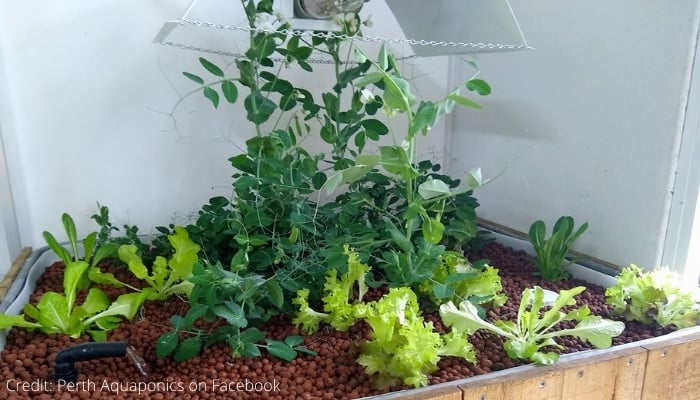Indoor aquaponics offers the perfect fusion of maintaining an aquarium and growing plants as a single hobby.
Whether for food, for fun, or for educational purposes, operating an aquaponics system is a great activity that’s rewarding in more ways than one.
Aquaponics is possible both inside and outside of the home. Indoors aquaponics requires a fish tank, live fish, live plants, a growing tray, growing medium, nutrients, pH meter and adjusters, and a couple of other odds and ends depending on the system you choose. And, it’s far easier than you ever imagined.
Read on below to learn everything you need to know about indoor aquaponics and exactly how it works, as well as reviews on some of the best indoor aquaponic systems to buy right now!
Indoor Aquaponics: How It Works
The way that indoor aquaponics works isn’t much different than outside hydroponics; a tank full of fish, water, nutrients, and oxygen feeds live plants in a growing bed via pipes, hoses, and a water pump. The water drains or recirculates back into the tank, and the cycle repeats itself indefinitely.
That’s the gist of it in a nutshell!
Indoor Aquaponic System Components
Now, let’s have a look at each of the components that make up indoor aquaponic systems.
Aquarium or Reservoir
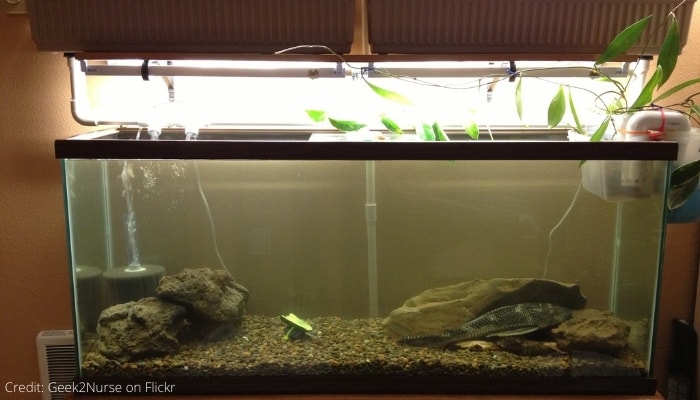
Credit: Geek2Nurse on Flickr
The tank that the fish are kept in also acts as the main nutrient and water reservoir for the entire system. Typically this is an aquarium of some shape or size. But, sometimes with indoor aquaponics totes, barrels, or other creative waterproof containers are used as well.
The size of the aquarium or reservoir utilized in an indoor aquaponics setup sets a limit on how large the rest of the system may be.
Water Pump
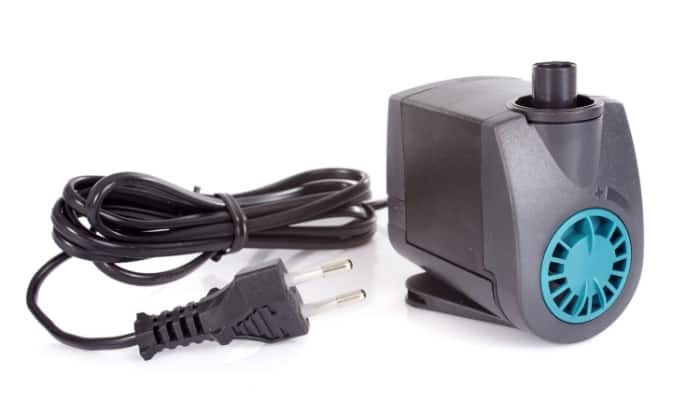
The water pumps that go in indoor aquaponic systems are normally small pond, fountain, or sump pumps. The most important factor of water pumps is how much water it can pump, and how many feet it can pump up and away from the reservoir.
The strength of the water pump goes a long way in determining what size operations the entire system is capable of.
Air Pump and Air Stone
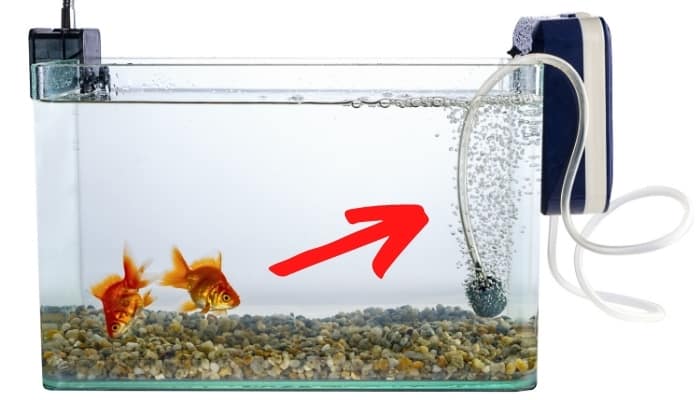
In aquaponics, the relationship between fish and plants typically covers all of the clean oxygen necessary. But, in some cases, you may find the need for an air pump and air stone to aerate the water in your system (as is the case with most hydroponic systems).
Grow Bed or Growing Tray
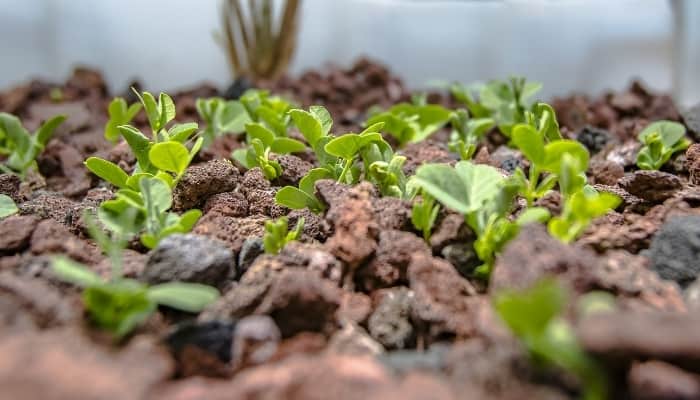
In the area that the plants are grown in, the bed or tray must be sturdy enough to hold the weight of the growing medium and water flow. It must also house the plants and the additional weight they attain as they grow in size.
Pipes, Tubes, and Hoses
Depending on the type and layout of your aquaponic system, a series of pipes, hoses, and/or tubes connect the main reservoir’s water pump to the growing bed(s). They are also utilized for creating a gravity-fed drainage system from the grow bed back to the main reservoir.
Lighting Requirements for an Indoor Aquaponic System
The lighting requirements for indoor aquaponic systems vary wildly from small personal systems to medium, large, or commercial-sized operations.
The amount of light required by indoor aquaponic systems also depends on the type of plants (and fish) that you grow (or intend to).
How Much Light Is Needed?
Anywhere from 10 to 20 hours of light may be necessary for an ordinary indoor aquaponics system. Again, this varies from species to species.
Houen from gardening.stackexchange.com says this about the light requirements of lettuce:
“I have had excellent indoor results with two T5 fluorescent tubes per 8 heads…When the plants are germinating from seed (until they get their first true leaf, most often the third one), I run the lights about 6 hours per day. Once they get their true leaves, I run the lights 10-12 hours per day.”
Just be sure you research the light requirements of each plant you choose to grow.
Types of Grow Lights
There are numerous types of lights that work with aquaponics, however, these four are the most effective and widely used:
- T5 fluorescent (High Efficiency and High Output)
- Full Spectrum LEDs (Light-Emitting Diodes)
- HID (High-Density Discharge)
- CFL (Compact Fluorescent)
Grow Light Placement
The placement of grow lights also varies from setup to setup and species to species. But, as a general rule of thumb, fluorescent and LED lights should be placed anywhere from 6 to 12 inches above plants.
All other types of bulbs have larger heat signatures and should be placed a minimum of 24 inches or more away from the tips of plants.
Adjustable lighting harnesses are highly recommended (as they allow you to slowly lift your lights up at the same rate of growth as your plants).
Types of Indoor Aquaponic Systems
Indoor aquaponics is a lot like indoor hydroponics, there are several preferred ways to go about it. The most popular form of indoor aquaponics is deep water culture (DWC), media bed, and nutrient film technique (NFT).
While there are far more ways to skin this cat than the three methods listed above, they are most definitely the most common and effective.
How Big Can an Indoor Aquaponic System Be?
The sky’s the limit (or, in this case, the size of your indoor area). It all depends on the space you have for setting up your system.
A small aquaponics setup could fit on an end table in the living room or tabletop. That said, if you’re growing in a garage, you could have multiple tanks set up as well as a number of media beds of DWC grow sites.
Likewise, in an even larger space, a commercial-size indoor aquaponic system is more than possible.

A large-scale, vertical aquaponics farm inside of a warehouse.
Indoor Aquaponics Routine Maintenance
Aquaponics routine maintenance is simple but demanding:
- Monitor the pH and water temperature regularly
- Feed fish regularly (and remove uneaten food)
- Harvest mature fish
- Move baby fish into a separate tank
- Check for leaks and visually inspect all components
- Fix, modify, or replace parts as needed
- Keep water levels topped off regularly
Potential Food Production Amounts With Indoor Aquaponics
The amount of food that an indoor aquaponics system may produce depends on several important factors; the size of the reservoir and growing area, the amount of fish occupying the system, the type of plants being grown, and more.
That said, some pre-made systems boast potential food production amounts of several hundred combined pounds of food (including fresh fish).
Best Plants To Grow With Indoor Aquaponics
Nearly anything is growable indoors via an aquaponic growing system. However, there are some plants that are just far better to grow with indoor aquaponics than others.
The best plants to grow with indoor aquaponics include:
- Basil
- Cabbage
- Cauliflower
- Chives
- Cucumbers
- Eggplant
- Lettuce
- Kale
- Microgreens
- Mint
- Peppers
- Spinach
- Strawberries
- Tomatoes
- Watercress
Best Fish To Use for Indoor Aquaponics
Like with plants, the list of fish to use for indoor aquaponics is a massive one. Thankfully, the list of the actual best fish to use for indoor aquaponics is a bit shorter:
- Tilapia
- Bass
- Bluegill
- Carp
- Catfish
- Goldfish
- Guppies
- Koi
- Perch
- Trout
- Yabbies
Can Indoor Aquaponic Fish Be Eaten?
Fish raised within indoor aquaponic systems are just as edible as any other fish. If the system is functioning properly, there is little to no difference in the nutritional value of fish raised indoors as to the ones raised outdoors.
That said, not every type of fish is meant to be eaten (indoor or outdoor). For example, goldfish, guppies, and koi are ornamental fish. You’d never want to eat them. Pretty much everything else is fair game!
Best Indoor Aquaponics Kits
We took a look at several indoor aquaponic kits currently available on the market and evaluated them based on various factors including water capacity, plant capacity, key features, ease of use, and overall quality in general.
We believe that each of the kits that made our list is well worth your consideration if you’re thinking about investing in one.
Professional Aquabox Complete System
- Key Features: Reservoir, pump, tubing, beautiful woodwork
- Water Capacity: 30 gallons
- Plant Capacity: 12+
One of our very favorite indoor aquaponic systems is the Professional Aquabox Complete System. Not only is this thing gorgeous, but it comes with everything needed to get started with aquaponics except for the live fish and plants.
It sports a fancy wood design custom fit with waterproof material and is made by hand in the USA. The only downside is the cost of shipping.
Pros
- Includes complete system
- Easy to use
- Hand-made
- High-quality
Cons
- Expensive
Back to the Roots Water Garden
- Key Features: Sleek design, grow bed built into the tank
- Water Capacity: 3 gallons
- Plant Capacity: 3+
An excellent aquaponics system for aesthetic value, or for teaching kids about growing things and the relationship between plants and fish, few systems offer a better value than the Back to the Roots Water Garden.
It features a sleek and simple design and works well for growing microgreens, small herbs, chives, lettuce, and more. It includes everything needed to get started and even comes with a guarantee that the system will work.
Pros
- Affordable
- Simple and appealing
- Includes everything
- Guaranteed to grow
Cons
- Small tank
- Small grow bed
Kingro 5-in-1 Indoor Gardening System
- Key Features: Fishtank, LED light, grow bed, filter, and built-in wicking
- Water Capacity: 7 gallons
- Plant Capacity: 20
Another excellent indoor system for getting started with aquaponics is the Kingro 5-in1. This bad boy looks great and works well for growing food as well as housing fish. It has enough space for up to 20 plants, features a quiet filter, and uses very little energy.
This system works for flowers, herbs, microgreens, and small veggies as well. It even features a built-in timer so you don’t have to worry about it for 10 days at a time if you prefer.
Pros
- Includes everything (even a light)
- Grows up to 20 plants
- The wicking system conserves water
- Energy-efficient lighting
- Looks awesome
Cons
- Isn’t as heavy-duty as other systems
ECO-Cycle Indoor Aquaponic System
- Key Features: Grow bed, light, framework to fit onto standard 20-gallon tanks
- Water Capacity: 20 gallons
- Plant Capacity: 12+
The only indoor system on our list to not feature a tank of its own is the ECO-Cycle Indoor Aquaponic System. If you already have a standard 20-gallon tank, this could be the product for you.
The kit includes a frame that attaches a grow bed to the top of your fish tank and has a light built-in as well. It comes with video instructions for installing and using it as well as having open phone lines for those who need a bit of help with the process.
Pros
- Easy to install and use
- Grow settings
- Remote control
- Built-in timer
- Great for kids
Cons
- Doesn’t include an actual reservoir
Regulating Water Temperature for Indoor Aquaponics
Keeping your water temperature stable is a key aspect of maintaining a well-balanced indoor aquaponics system. There are numerous ways to do so, you simply need to choose which one(s) make the most sense to you!
- Paint the tank a solid color
- Use reflective material around the tank
- Insert a water coil into the reservoir
- Use ventilators
- Run the AC
- Utilize a swamp cooler
- Keep the water topped off regularly
- Add fish and plant-friendly water coolant liquid
- Grow plants that require specific temperatures
Monitoring pH Levels
The pH level of the water in aquaponic systems is vital for the entire system. A good pH balance allows for a thriving system full of healthy plants and fish.
But, once the pH drops below, or raises above, the correct level, the whole system is quickly thrown out of whack. That means fish and plants may suddenly start dropping like crazy.
To monitor the pH in your system, simply use an electronic pH meter or test strips to check the water. Monitoring pH levels is a daily exercise because even one day can result in a system failure in worst-case scenarios.
Once you have your pH reading each day, simply take note of it (to compare to tomorrow’s number), or adjust it as needed. Adjusting pH is as simple as sprinkling powder or squirting a bit of liquid into the tank, waiting a few minutes, and retesting the water.
What To Feed Aquaponic Fish
Aquaponic fish can eat a number of different types of food. Insects like cockroaches, crickets, and flies are among the most popular foods for fish in aquaponic systems.
Insect larvae and other ooey and gooey critters like earthworms and grubs are also highly recommended.
You may also opt to feed your fish with store-bought fish food. If so, familiarize yourself with the species of fish you are raising and make sure the ingredients match their needs.
It is also recommended to check fish food for GMO ingredients before purchasing.
Can You Do Aquaponics Without a Pump?
Technically speaking, it is indeed possible to do aquaponics without a water pump. That said, in order to do so, you need to find a way to empty the water from the very bottom of the fish tank directly into the growing bed.
A Final Word About Indoor Aquaponics
Indoor aquaponic systems are a great way not only to grow things, including fish, but they are also a wonderful educational tool for people of all ages. No previous gardening skills are necessary to get started with indoor aquaponics either.
Hopefully, with all of the helpful information above, you can make an easier decision as to if indoor aquaponics is a good choice for you (and if so, which system is right for you!).

